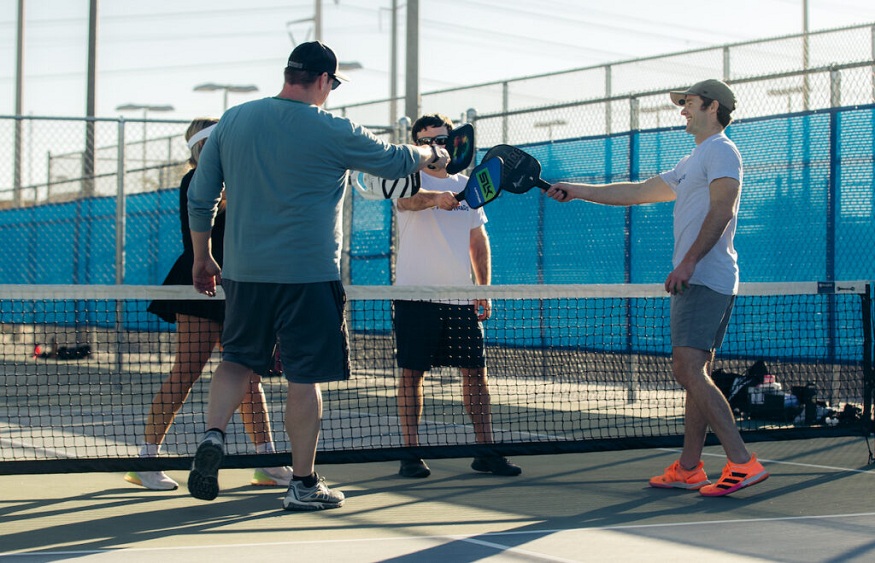Community Pickleball Courts: Fostering Social Connections
Pickleball, once confined to sports facilities, has now transcended its competitive roots to become a vibrant social activity, thanks to the rise of community Pickleball courts. In this article, we explore the evolution of Pickleball into a social sport, the benefits it brings to communities, and the ways in which it fosters social connections among players.
Introduction
Read more: How to Engage in Pickleball Like a Pro?
Defining Community Pickleball Courts
Community Pickleball courts go beyond being mere playing surfaces; they serve as hubs for social interactions, fostering connections among individuals of diverse backgrounds. The clang of paddles and the rhythmic bounce of the Pickleball have become the backdrop to vibrant community life.
Rise of Pickleball as a Social Sport
1. from Sport to Social Activity
Pickleball has experienced a remarkable shift from being solely a competitive sport to a recreational and highly social activity. Communities are witnessing an influx of players seeking not only physical activity but also social engagement.
2. Multigenerational Appeal
One of the key factors contributing to the social aspect of Pickleball is its multigenerational appeal. Players of all ages find themselves on the same court, breaking down barriers and creating a unique social dynamic.
Benefits of Community Pickleball Courts
1. Physical Health Benefits
Engaging in Pickleball provides a fun and effective way to stay physically active, contributing to improved cardiovascular health, flexibility, and overall fitness.
2. Social Well-being
Community Pickleball courts become social hubs, promoting mental well-being through social interactions, laughter, and shared experiences.
Inclusivity and Diversity in Pickleball Communities
1. Bringing People Together
Pickleball transcends demographic boundaries, bringing together individuals from various occupations, fostering diversity, and creating a sense of unity.
2. All Ages, All Abilities
Communities witness a mix of players, from seasoned athletes to beginners, displaying the sport’s inclusivity and making it accessible to everyone.
Designing Welcoming Pickleball Spaces
1. Court Layout and Amenities
Creating a welcoming environment involves thoughtful court layout, seating areas, and amenities that encourage socializing before and after games.
2. Community Input
Incorporating input from the community in the design process ensures that the courts reflect the preferences and needs of the players.
Local Initiatives and Pickleball Events
1. Organized Play Sessions
Local initiatives, such as organized play sessions and round-robin tournaments, contribute to community bonding and a sense of shared purpose.
2. Social Events beyond the Court
Communities often organize social events beyond the court, such as picnics, barbecues, and fundraisers, creating opportunities for deeper connections.
Pickleball as a Catalyst for Social Bonds
1. Stories of Friendship
Anecdotes of lasting friendships formed on Pickleball courts abound, illustrating the power of the sport as a catalyst for meaningful social bonds.
2. Building a Supportive Community
Pickleball communities often evolve into support systems, with players cheering each other on, both on and off the court.
Case Studies of Successful Community Pickleball Projects
1. Pickleball Paradise
Examining a community project that transformed underutilized spaces into a thriving Pickleball haven, displaying the positive impact on social connections.
2. Pickleball Association
A case study of a citywide Pickleball association that successfully implemented programs to enhance community engagement.
Challenges and Solutions
1. Balancing Demand
Challenges arise when demand exceeds court availability. Solutions may include staggered playing schedules, court expansion, or the creation of additional facilities.
2. Maintenance and Sustainability
Ensuring the long-term success of community Pickleball courts involves addressing maintenance challenges and implementing sustainable practices.
Pickleball Clubs and Social Gatherings
1. Role of Pickleball Clubs
Pickleball clubs play a pivotal role in organizing events, providing resources, and fostering a sense of belonging among players.
2. Monthly Social Gatherings
Communities with regular social gatherings, such as monthly meet-ups or themed events, experience heightened camaraderie among players.
Testimonials from Community Pickleball Enthusiasts
1. Finding Family on the Court
A personal testimonial highlighting how a player found a sense of family and belonging within the community of Pickleball enthusiasts.
2. from Strangers to Friends
A story narrating the journey of two individuals who started as strangers on the court and became enduring friends.
The Role of Pickleball Coaches in Community Building
1. beyond Coaching Skills
Pickleball coaches often go beyond imparting playing skills, contributing significantly to the community-building aspect by fostering a positive and inclusive environment.
2. Mentorship and Guidance
Coaches serve as mentors, providing guidance not only on the court but also in navigating the social dynamics of the Pickleball community.
Social Media and Online Platforms for Pickleball Communities
1. Community Building in the Digital Age
The role of social media platforms and online forums in connecting Pickleball enthusiasts, organizing events, and sharing experiences.
2. Virtual Workshops and Seminars
The digital space allows for virtual workshops and seminars, promoting continuous learning and community engagement.
Educational Programs and Workshops
1. Understanding the Rules
Educational programs focusing on understanding the rules of Pickleball contribute to a smoother and more enjoyable playing experience.
2. Skill-building Workshops
Workshops that focus on skill building cater to players of all levels, creating a culture of continuous improvement within the community.
Conclusion
In conclusion, community Pickleball courts serve as catalysts for social connections, providing spaces where individuals come together to enjoy a shared passion for the sport. The benefits, challenges, and real-life examples presented in this article highlight the significance of Pickleball in fostering inclusivity, diversity, and a sense of community. As we witness the continued growth of Pickleball communities, it is evident that the sport goes beyond the confines of a court—it becomes a vibrant tapestry of social connections.
FAQs about Community Pickleball Courts
- How can communities initiate the development of Pickleball courts?
- Communities can start by conducting feasibility studies, garnering community support, and collaborating with local authorities for funding and approval.
- Are there specific guidelines for designing Pickleball courts for community spaces?
- Yes, guidelines provided by organizations like the USA Pickleball Association (USAPA) offer standards for court dimensions, materials, and amenities.
- What role do local businesses play in supporting community Pickleball initiatives?
- Local businesses can contribute through sponsorships, providing equipment, or participating in community events to support Pickleball initiatives.
- How can individuals contribute to building a sense of community on Pickleball courts?
- Individuals can actively participate in local events, be welcoming to new players, and engage in positive social interactions on and off the court.

